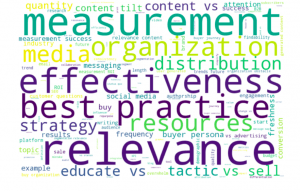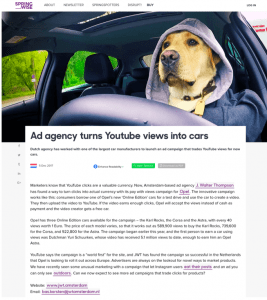
Top 100 Content Marketing Questions Answered
In workshops, marketers have asked me over 2,100 questions about content marketing. Their questions provide great insights into content marketers, content marketing jobs to be done, and the content marketing journey.
Here are answers to the Top 100 Content Marketing Questions, which span B2C and B2B content marketing. To search for answers by topic, use these quick links:
Organization – 21 questions & answers
Strategy – 24 questions & answers
Relevance – 21 questions & answers
Distribution – 15 questions & answers
Conversion – 8 questions & answers
Measurement – 36 questions & answers
Here’s a blog about our methodology to gather over 2,100 questions, analyze them with artificial intelligence (AI), and answer the most important questions.
So far we’ve answered 125 questions. Why did we answer more than 100? Because marketers’ questions change over time. As we answer new questions, we won’t remove the questions and answers that came from earlier analyses.
ORGANIZATION
 Here are 10 proven ways that content marketing can help generate sales and revenues. Each will help you gain Sales buy-in.
Here are 10 proven ways that content marketing can help generate sales and revenues. Each will help you gain Sales buy-in.
Anything that puts more money in their wallets, Sales will embrace – including digital marketing and content marketing.
 Look at size and scale constraints as an advantage in content marketing, because they force you to focus. To make your small team into an advantage, do David and Goliath content marketing.
Look at size and scale constraints as an advantage in content marketing, because they force you to focus. To make your small team into an advantage, do David and Goliath content marketing.
To succeed with a small team, focus on your advantages. Be bold. Be controversial. Be quick.
This blog post includes my SlideShare presentation from Content Marketing World (CMW).
 When you need effective ways to Tweet, consider these 4 approaches to Twitter:
When you need effective ways to Tweet, consider these 4 approaches to Twitter:
– Make it brief and timely.
– Evoke strong emotion.
– Add visuals.
– Spark dialogue.
 Some companies find it nearly impossible to break the campaign habit. So they resist any move toward content marketing.
Some companies find it nearly impossible to break the campaign habit. So they resist any move toward content marketing.
But almost 9 out of 10 marketers apply content marketing today. Others are striving to catch up.
To succeed, first marketers have to prove that content marketing can be successful in their company.
 To create content marketing converts:
To create content marketing converts:– Contrast content marketing and advertising.
– Address 3 key questions about buyer needs in your market.
– Share data on eroding ad performance and content marketing growth.
– A/B test advertising and content marketing.
Give your customers a taste of digital marketing and interactive content, which TV ads cannot do.
Read More
 To develop a successful content marketing program:
To develop a successful content marketing program:– Avoid over-reliance on an agency “black box.”
– Pinpoint the exact problems buyers are trying to solve.
– Collaborate with stakeholders to co-create a mission, strategy, and message.
 – Build a big tent to co-create strategy.
– Build a big tent to co-create strategy.– Educate about why the company needs content marketing.
– Advocate for customer-centric content.
– Run pilot programs to produce proven successes.

Marketers constantly face the need to quickly adapt content across communications channels, audiences, and media to get the word out fast. First, create an overarching message and strategy quickly. Then, adapt the message and strategy to the needs of each audience, channel, and medium.
Read More

To sustain momentum in content marketing:
– Understand what consumers and B2B buyers need and want.
– Build an audience-centric content calendar.
– Add other people’s voices.
Read More
 Content is about creating information pages that lead to selling pages. Help SMEs understand content marketing, so they see that brands need both kinds of pages to sell effectively.
Content is about creating information pages that lead to selling pages. Help SMEs understand content marketing, so they see that brands need both kinds of pages to sell effectively.
 When the advertising vs. content marketing debate surfaces, helps senior managers become self-aware about their own behaviors as consumers of marketing. Great content marketing is all about putting teaching before selling.
When the advertising vs. content marketing debate surfaces, helps senior managers become self-aware about their own behaviors as consumers of marketing. Great content marketing is all about putting teaching before selling.
Your content marketing agency or consultant can help you position content marketing efforts favorably so you gain the freedom to work.
 To maximize content: Create a dedicated content team with content creators, an experienced content marketing manager and a Chief Content Officer. Find the right mix of skills. Get the whole company on the same page. Organize content editorially, like a newspaper. Choose marketing tools wisely.
To maximize content: Create a dedicated content team with content creators, an experienced content marketing manager and a Chief Content Officer. Find the right mix of skills. Get the whole company on the same page. Organize content editorially, like a newspaper. Choose marketing tools wisely.
STRATEGY

First, business-to-business (B2B) content marketing must keep bluebirds separate from your other measures – such as planned won and planned lost sales – so that these results stay pure.
Read More

You win by helping buyers comparison-shop.
Because everything you do that helps buyers complete evaluations quicker will reduce friction and advance buyers toward a purchase.
Read More

These are the right questions to ask when you need to win over a key audience. To clarify this question for our clients, we ask:
Who’s your most challenging target audience?
Do we have research or insights on how they differ from other audiences?
What are the root causes of the challenge? What is it that makes this target audience so hard to reach?
Read More

How do you communicate a clear content strategy and message map to all marketing channels? Take these three actions:
Involve the right stakeholders in creating your message map and content strategy so you reach the right target audiences.
Agree on marketing metrics.
Consistently and frequently communicate updates, progress, and metrics.

Here’s how you can create a corporate story that everyone in your company, including every business unit, can tell.
Start at the company level.
While it may seem daunting to try to create one message that covers the entire company, it’s the best place to begin.
To get you started, discover your company’s mission, vision, and purpose — all essential for content creation — so that you, your content marketing agency, consultants, and freelancers all get on the same page.

Aligning your company around a content marketing strategy can be a struggle. Why?
We see content marketers suffering from:
A lack of internal understanding about what content marketing is, sometimes even inside Marketing.
The absence of a clear mission and role for content marketing on a brand.
A false expectation that you need a 3-inch-thick binder to create a solid strategy. In fact, a one-page documented content marketing strategy does enough to guide your content marketing efforts.

Due to COVID, the traditional marketing strategies went out the window a while ago. Robert Rose suggests that marketers “stop posting for a moment, sit back and architect the right strategy for your business. Then lean in heavily and execute it brilliantly.”
As you start planning marketing during the pandemic, you need to adapt to customers’ new media habits – such as a preference for video and interactive content. Make sure brand messages remain relevant in changing times.

The short answer: yes, customer-first content is a winning strategy. Here’s why:
Putting customers first, understanding what they need, and building trust with empathetic, differentiated content is a roadmap to long-term marketing success. You’ll find plenty of content ideas, once you get to know your customers well enough.

Increasingly, CEOs and companies must speak out. That raises the question: what should business leaders say right now? What jobs should business-to-consumer (B2C) and business-to-business (B2B) content marketing do in light of the pandemic and social changes?
Speak Out
Use a Clear Moral Compass
Lead with Empathy and Humanity

A Message Map helps you say it, share it, tweet it, blog post it, publish it, and debate it well. By using Message Maps consistently, you can make your marketing, employee, and investor communications even more harmonious and successful — and ensure that you deliver quality content.
Read More

To build a content marketing strategy from scratch, content marketers must gain internal buy-in.
Inside the company, build buy-in by collaborating with colleagues to co-create your content marketing mission, strategy, and message.
Here’s a step-by-step process for how to build a documented content marketing strategy from scratch:

Marketing automation supports content marketing by getting 4 jobs done for you:
– Track users’ interests to recommend relevant content streams.
– Assign scores to users to decide which are ready to contact and qualify.
– Offer content that helps buyers qualify themselves.
– Enable reverse engineering of successful content-to-customer conversions.
The more responsibility marketing has for inbound marketing and revenue goals, the more important it is to use a marketing automation platform.

To get better at content marketing, you’ll need to learn from others. To do so, look for the right boss, the right blog, the right books, and the right tribe. Participate in events like Content Marketing World (CMW).
Read More

People are impatient. If you can’t hook your audience in 7 seconds, people may not stick around long enough to get your message.
Read More

Marketers constantly face the need to quickly adapt content across communications channels, audiences, and media to get the word out fast. First, create an overarching content marketing plan, message, and strategy quickly. Then, adapt the message and strategy to the needs of each audience, channel, and medium.
Read More

Marketers who write a content marketing strategy are 4 times more successful, says Joe Pulizzi. Yet only fewer than half of marketers have a documented content marketing strategy.
Read More

If you’re afraid that your evergreen content is getting stale, here’s how to re-purpose content, squeeze out more value, and expand your audience.
Read More

Learn your buyers through buyer personas or question analysis. Use content analytics. Serve relevant messages to each buyer.
Read More
RELEVANCE

I’m often asked how best to apply content marketing to a highly educated audience with specialized buyers. What all marketers need, regardless of buyers’ education and specialty, is a mix of content targeted at specific buyers during each stage of the buyer journey.
Read More

To address different demographics with relevant content, marketers need to:
Know your audience.
Consider 7 key factors.
Understand what people want and don’t want from content.
Read More

Tune into your customers and your brand personality. The better you know your brand and your customers, the more in-tune your voice will sound.
Read More

Target content marketing effectively by identifying the right audience of buyers – the tribe that craves your content. Find out which information they need to become smarter buyers in your market.
Then, provide the best information buyers can find on key topics, in the places they hang out.
Read More

To sustain momentum in content marketing:
– Understand what buyers need and want.
– Build an audience-centric content calendar.
– Add other people’s voices.
Read More

The 2018 studies by the Content Marketing Institute (CMI) and Marketing Profs show what the most popular types of content are.
Read More

Andrew Davis answers a crucial content marketing question and he’s one of the most exciting speakers you’ll ever hear.
Read More

The best way to better engage readers is gradual.
Let readers set the pace. Don’t dump too much information (TMI) on them all at once.
Read More
DISTRIBUTION

The answer: it depends on your audience’s information habits. That said, the tips below will help you maximize audience engagement with content, whatever its frequency.
Put audience needs first
Know your buyers and especially their information habits.
Read More

Four key trends will drive the future of social media marketing and content marketing:
1. Usage is up: Americans are using social media more during the COVID-19 crisis. About half are consuming even more content.
2. Trust is down: But trust in social media is strained, due to fake news and fake accounts.
3. Dependency brings dangers: Marketers absolutely depend on social media today as their #1 content marketing channel, both organic and paid.
Some marketers are reducing their social media marketing to invest more in owned content and earned content.
Read More

The 4 keys to aligning content with channels are:
– Know your audience.
– Deliver content that’s on mission, on strategy, and on message.
– Deliver content at the right time.
– Use the right media mix.
Read More

Balance audience size and engagement. The audience size only tells part of the story. Marketers who build a smaller, highly engaged audience can outperform those who focus on a bigger but less engaged audience. Long-form content like white papers attracts B2C and B2B buyers who are making a carefully considered purchase.
Read More

Target content marketing effectively by identifying the right audience of buyers – the tribe that craves your content. Find out which information they need to become smarter buyers in your market.
Then, provide the best information buyers can find on key topics, in the places they hang out.
Read More

Here are 3 ideas to help you discover the ideal email frequency for your brand:
– Let subscribers choose the ideal email frequency.
– Test to find out the ideal email frequency for your list.
– AI (artificial intelligence) can identify the weeks to avoid sending mega-content emails.
Read More

Up to 1/3 of web pages offer duplicate content:
Some search engine optimization (SEO) experts believe that your search engine rank can be hurt by duplicate content. Others say that’s a myth.
Read More

To promote content marketing efforts effectively, take 3 approaches:
1. Owned media
Why? Because no one can take away these assets or arbitrarily raise your rent.
2. Earned media
Expand your influence by borrowing other people’s audiences.
3. Rented (aka Paid) media
To expand your reach and amplify your message, use paid advertising.
Read More

Just as animals go to their usual watering holes, so do buyers searching for information. Expect them to use Google search, so offer a great piece of content like a white paper or research study.
Don’t build a new watering hole, because the job of luring buyers to a new place is expensive, uncertain, and fraught with risks.

Use these 4 keys to engagement:
1. Evoke an emotional response.
2. Keep content newsy and fresh.
3. Make content interactive.
4. Encourage user-generated content.
Read More
CONVERSION
Top 100 Content Marketing Questions Answered

In the eyes of buyers, testimonials are absolutely essential.
Without them, buyers can’t complete all the steps in the buyers’ journey toward a carefully considered purchase. Many buyers skip over brands that lack testimonials or social proof.
Read More

Whether or not to gate content is a common dilemma, because an estimated 80% of B2B content marketing assets are hidden behind a gate. So approach the question of gated content from a buyer’s viewpoint.
Read More

Marketers jealously guard their inbound marketing results – including conversion rates of content marketing. That’s why it’s so hard to find information about typical conversion rates of content marketing.
Why don’t people share conversion rates? Because their competitors would love to know.
Conversion rates of content marketing vary dramatically, driven by these variables: Industry, Company, Product or service, Customer list (subscribers), Timing, and Offer.
Read More

Content creators, you should expect content marketing to take 1 to 2 years, plus or minus, to show its full effects. The speed of your content marketing results depends on your product’s sales cycle:
If it usually takes a year to close a sale of your product, expect visible results in 18 to 24 months.
If it’s a quicker-moving product that sells in 30 to 60 days, you start to see results in the first 3 to 6 months.
Plan your content marketing campaigns accordingly.
Read More

Marketers use content marketing all through the sales funnel. Consumer marketers create content to build the top of the funnel first, says the 2019 CMI research:
– 4 out of 5 marketers use content to build brand awareness.
– 2 out of 3 use content to build credibility and trust.
Read More

To clearly connect content marketing to revenue, take these 4 steps:
– Prove the effectiveness of content marketing by ring-fencing one specific market where the only marketing is content marketing.
– Before you create any content, find out which content buyers need the most through buyer persona research.
Read More
MEASUREMENT
 Many marketers lack the time, money, or expertise to do comprehensive marketing metrics. But you can use Google Analytics to learn a lot. Measure and guide your content, including social media marketing, with our rules of thumb.
Many marketers lack the time, money, or expertise to do comprehensive marketing metrics. But you can use Google Analytics to learn a lot. Measure and guide your content, including social media marketing, with our rules of thumb.Read More
 The most meaningful web traffic comes from potential customers who need answers, seek authoritative content, and find exactly what they need on your website. Google Analytics and similar tools are the keys.
The most meaningful web traffic comes from potential customers who need answers, seek authoritative content, and find exactly what they need on your website. Google Analytics and similar tools are the keys.Read More
 To prove content drives sales and brands, take these steps:
To prove content drives sales and brands, take these steps:– Take a strategic approach to content marketing by building a foundation.
– Appoint a manager, one neck to grab, for analytics and conversion.
– Focus on analytics that drives marketing effectiveness and business results.
Read More
 Here are 5 ways to prove content marketing is working.
Here are 5 ways to prove content marketing is working.Anyone is sufficient, but two or more will make your case for content even more convincing.
1. Trace customers from content discovery to profitable sales.
Read More
 When you consider how to measure your content marketing – individual pieces of content vs. the overall success of content marketing:
When you consider how to measure your content marketing – individual pieces of content vs. the overall success of content marketing:– Be clear about your purpose in measuring.
– Strike the right balance in measuring programs, campaigns, and pieces.
– Use tricks that improve the measurability of individual pieces.
Read More

Marketing attribution is the key to measurement, and it’s the #1 challenge consumer marketers face. My study of more than 2,100 questions from marketers confirmed that this is a major pain point for marketers.
Read More

Marketers jealously guard their results – including conversion rates of content marketing. That’s why it’s so hard to find information about typical conversion rates of content marketing.
Why don’t people share conversion rates? Because their competitors would love to know.
Conversion rates of content marketing vary dramatically, driven by these variables: Industry, Company, Product or service, Customer list (subscribers), Timing, and Offer.
Read More

Generally, content marketing takes 1 to 2 years, plus or minus, to show its full effects. The speed of your content marketing results depends on your product’s sales cycle:
If it usually takes a year to close a sale of your product, expect visible results in 18 to 24 months.
If it’s a quicker-moving product that sells in 30 to 60 days, you start to see results in the first 3 to 6 months.
Read More

Content marketers carefully choose which marketing metrics to share with executives, with internal clients, and inside the marketing department.
Read More

To create a test and learn environment, focus first on creating an innovation culture in the Marketing Department.
Read More

Get the whole team aboard
To demonstrate the impact of content marketing, start by getting your executives and internal clients aboard the content marketing bandwagon. They are used to traditional marketing, so it will take some time to educate them. Take these steps:
Convene decision-makers in a workshop
Read More

To measure content marketing effectively, measure to improve performance, enable testing and share the most relevant results.
Read More

To measure the success of user-generated content (UGC), be:
– Clear about its purpose
– Ready to relinquish some control
– Set up to measure the right results.
Read More

To track conversions, invite soft conversions first, and hard conversions next. The right calls to action can get great responses.
Read More

Why are marketers always on the lookout for sources of content marketing ideas? Because our audiences are always hungry for content on relevant topics with fresh story angles.
The most valuable sources of content marketing ideas:
– Resonate with your audience.
– Unlock expertise inside your company and customers.
– Fit the moment.
Read More

Content marketing plays multiple roles to grow your business
To measure content marketing in your business, take these steps:
– Measure the value of content as a long-life asset.
– Be crystal-clear about the jobs you want the content to do.
Read More

To start out, assess content marketing effectiveness in 4 ways. Discover:
– Is your content on target, on mission, on strategy, and on message?
– Is your content being found by buyers?
– Are buyers consuming your content?
– Are buyers moving forward toward a purchase?
Read More

Content marketing can achieve many different marketing goals. To measure the value of content marketing, spell out your goals in writing, in advance.
In other words, write down your content marketing mission and content marketing strategy. Whether you’re a B2C marketer or a B2B marketer, a documented content marketing strategy makes a difference.
Read More

Three reasons why tracking content marketing analytics is vital to success:
– What’s working and what’s not.
– Track buyers from content to conversion.
– Demonstrate content marketing results to higher-ups.
Read More

Here are 10 budget rules of thumb I developed as a manager, director, and vice president.
Budget rules of thumb make it easier to secure the budget you need. I hope one or more of these budget rules of thumb helps you get the resources you need to succeed as a content marketer.
Read More

How does the content make your reader’s job easy? When you measure good content, that’s the first question to ask. Your content marketing campaign should make your customers’ jobs easier to get done.
Read More

Out of all the questions marketers ask about content marketing, the most frequently asked question is: How to measure success?
It’s a big-picture question that applies to content and all marketing activities – digital, event, email, and others.
Read More

Executives invest in marketing to produce growth in sales and revenue, new customers, and new deals. How do they measure marketing success?
And what should you avoid telling them?
Read More

Content creators, look for measures that matter, track them faithfully over time, and adjust your content mix to become more successful.
Don’t worry about what you can’t measure. There’s plenty you can measure and learn from.
Read More

Measures that gauge the quality of content are too often overlooked. Yet they’re important because quality beats quantity in content marketing.
Read More












































